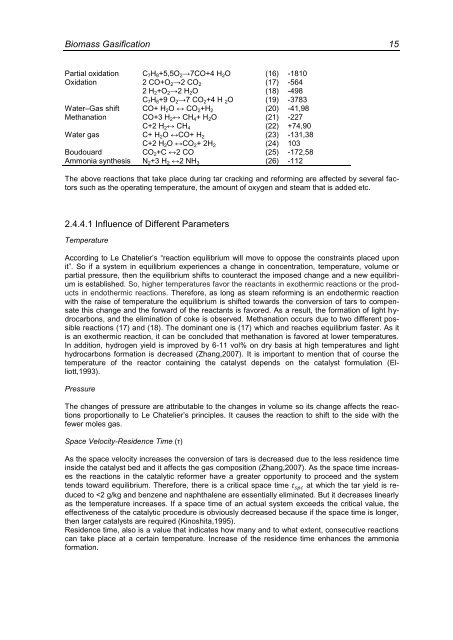Dipl. Ing. Matthias Mayerhofer Technische Universität München ...
Dipl. Ing. Matthias Mayerhofer Technische Universität München ...
Dipl. Ing. Matthias Mayerhofer Technische Universität München ...
You also want an ePaper? Increase the reach of your titles
YUMPU automatically turns print PDFs into web optimized ePapers that Google loves.
Biomass Gasification 15<br />
Partial oxidation C7H8+5,5O2→7CO+4 H2O (16) -1810<br />
Oxidation 2 CO+O2→2 CO2 (17) -564<br />
2 H2+O2→2 H2O (18) -498<br />
C7H8+9 O2→7 CO2+4 H 2O (19) -3783<br />
Water–Gas shift CO+ H2O ↔ CO2+H2 (20) -41,98<br />
Methanation CO+3 H2↔ CH4+ H2O (21) -227<br />
C+2 H2↔ CH4 (22) +74,90<br />
Water gas C+ H2O ↔CO+ H2 (23) -131,38<br />
C+2 H2O ↔CO2+ 2H2 (24) 103<br />
Boudouard CO2+C ↔2 CO (25) -172,58<br />
Ammonia synthesis N2+3 H2 ↔2 NH3 (26) -112<br />
The above reactions that take place during tar cracking and reforming are affected by several factors<br />
such as the operating temperature, the amount of oxygen and steam that is added etc.<br />
2.4.4.1 Influence of Different Parameters<br />
Temperature<br />
According to Le Chatelier’s “reaction equilibrium will move to oppose the constraints placed upon<br />
it”. So if a system in equilibrium experiences a change in concentration, temperature, volume or<br />
partial pressure, then the equilibrium shifts to counteract the imposed change and a new equilibrium<br />
is established. So, higher temperatures favor the reactants in exothermic reactions or the products<br />
in endothermic reactions. Therefore, as long as steam reforming is an endothermic reaction<br />
with the raise of temperature the equilibrium is shifted towards the conversion of tars to compensate<br />
this change and the forward of the reactants is favored. As a result, the formation of light hydrocarbons,<br />
and the elimination of coke is observed. Methanation occurs due to two different possible<br />
reactions (17) and (18). The dominant one is (17) which and reaches equilibrium faster. As it<br />
is an exothermic reaction, it can be concluded that methanation is favored at lower temperatures.<br />
In addition, hydrogen yield is improved by 6-11 vol% on dry basis at high temperatures and light<br />
hydrocarbons formation is decreased (Zhang,2007). It is important to mention that of course the<br />
temperature of the reactor containing the catalyst depends on the catalyst formulation (Elliott,1993).<br />
Pressure<br />
The changes of pressure are attributable to the changes in volume so its change affects the reactions<br />
proportionally to Le Chatelier’s principles. It causes the reaction to shift to the side with the<br />
fewer moles gas.<br />
Space Velocity-Residence Time (τ)<br />
As the space velocity increases the conversion of tars is decreased due to the less residence time<br />
inside the catalyst bed and it affects the gas composition (Zhang,2007). As the space time increases<br />
the reactions in the catalytic reformer have a greater opportunity to proceed and the system<br />
tends toward equilibrium. Therefore, there is a critical space time at which the tar yield is reduced<br />
to
















